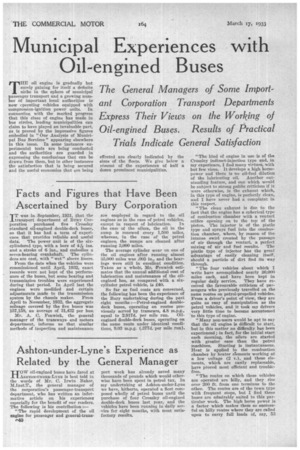Municipal Experiences with Oil-engined Buses
Page 90

Page 91

If you've noticed an error in this article please click here to report it so we can fix it.
THE oil engine is gradually but surely gaining for itself a definite niche in the sphere of municipal passenger transport and a growing number of important local authorities is now cperating vehicles equipped with compression-ignition power units. In connection with the marked progress that this class of engine has made in bus circles, leading municipalities can claim to have played an invaluable part, as is proved by the impressive figures embodied in "Our Analysis of Municipal Bus Services" appearing elsewhere in this issue. In some instances experimental tests are being conducted and the authorities are guarded in expressing the conclusions that can be drawn from them, but in other instances the satisfaction that is being secured and the useful economies that are being
effected are clearly indicated by the sizes of the fleets. We give below a résumé of the experiences of half a dozen prominent municipalities. "The hind of engine in use is of the Crossley indirect-injection type and, in my experience, I find many virtues, with but few vices. It develops a high horsepower and there is no oil-fuel dilution
of the lubricating oil. Another outstanding feature, and one which would be subject to strong public criticism if it were otherwise, is the exhaust which, in this type of engine, is perfectly clean, and I have never had a complaint in this respect.
"The clean exhaust is due to the fact that the engine has a spherical type of combustion chamber with a venturi orifice opening on to the top of the piston. The injector is of the pintle type •and sprays fuel into the combustion chamber, where, by reason of the intense swirl created by the passage of air through the venturi, a perfect mixing of air and fuel results. The pintle type of injector has the great advantage of easily cleaning itself, should a particle of dirt find its way through.
"The four vehicles about which I write have accomplished nearly 30,000 miles each, and have been kept in regular daily service. They have received the favourable criticism of passengers who previously travelled on the same routes on petrol-propelled vehicles. From a driver's point of view, they are quite as easy of manipulation as the petrol vehicles, and it took my drivers very little time to become accustomed to this type of engine.
"Many non-users would be apt to say that the oil engine is difficult to start, but in this matter no difficulty has been experienced ; in fact, for the initial start each Morning, the oilers are started with greater ease than the petrol machines. Starting is instantaneous. Heat is applied to the combustion chamber by heater elements working at a low voltage (2 v.), and these elements, which are easily replaceable, have proved most efficient and trouble free.
"The routes on which these vehicles are operated are hilly, and they rise over 200 ft. from one terminus to the other. The routes are of the town type with frequent stops, but I find these buses are admirably suited to this particular work. The high horse power is a factor which makes them so suceessful on hilly routes where they are called upon to carry full loads of, say, 53 passengers, and do it without any apparent fatigue or undue labouring.
"From a technical point of view there is a number of interesting features. The question of the fuel oil obtaining access to the crankcase has been rather cleverly dealt with in the Crossley engine. Atomizers are situated in small pockets on the near side, and these have no direct connection with the engine, other than into the combustion chamber. Further, any leakage of fuel which might occur from the atomizers cannot dribble down the cylinder wall into the crankcase, but rims into the small pockets and is then conveyed ,into small pipes which, in turn, carry it back to the fuel tank.
"I find in practice that the injectors are easily removed after taking off the cylinder-head cover. The CrossleY engine is fitted with 'wet cylinder liners of the hardened type and, from my experience, the actual wear compares favourably with that in a similarsized petrol engine. Replacement of liners is a simple matter.
"With regard to the cost of operation, we have saved quite a considerable sum in the half-year that these four vehicles. have been in service: We are getting approximately nine miles to the gallon of fuel used, the approximate cost of which is 4d., so that the power eost
s less than id. per mile, as against a petrol cost of over 2d. per mile. On the present basis it can be said that an oil-engined bus running 40,000 miles per annum is effecting a saving of £250 per vehicle.
"The maintenance of the oil-engined vehicles is as cheap as the petrol vehicles, Much care has to be exercised to ensure cleanliness in the fuel oil and in the jets, but these are matters of routine, and when such routine has once been installed it does not entail much further consideration." Mr. Lythgoe tells us that the drivers prefer the oil-engined vehicles, as they are much cooler, whilst the garage hands have experienced no difficulty in connection with starting-up in the mornings.
The corpOration's experience with its original oilers has been so satisfactory that it has recently bought two similar machines. An interesting point' which Mr. Lythgoe stresses relates to brakefacing life, the reduction' in wear as compared with a corresponding type of petrol bus being most noticeable.




































































































































































